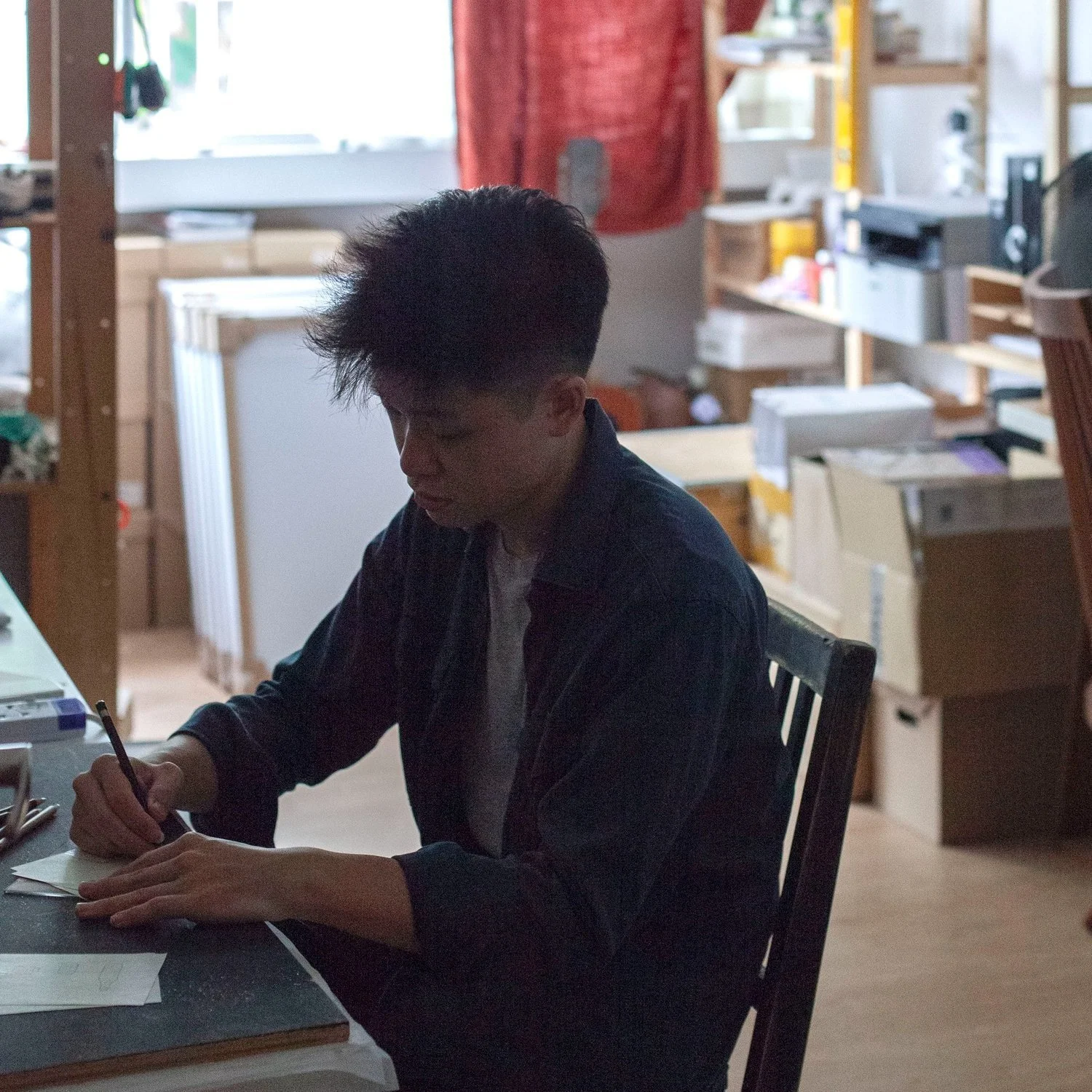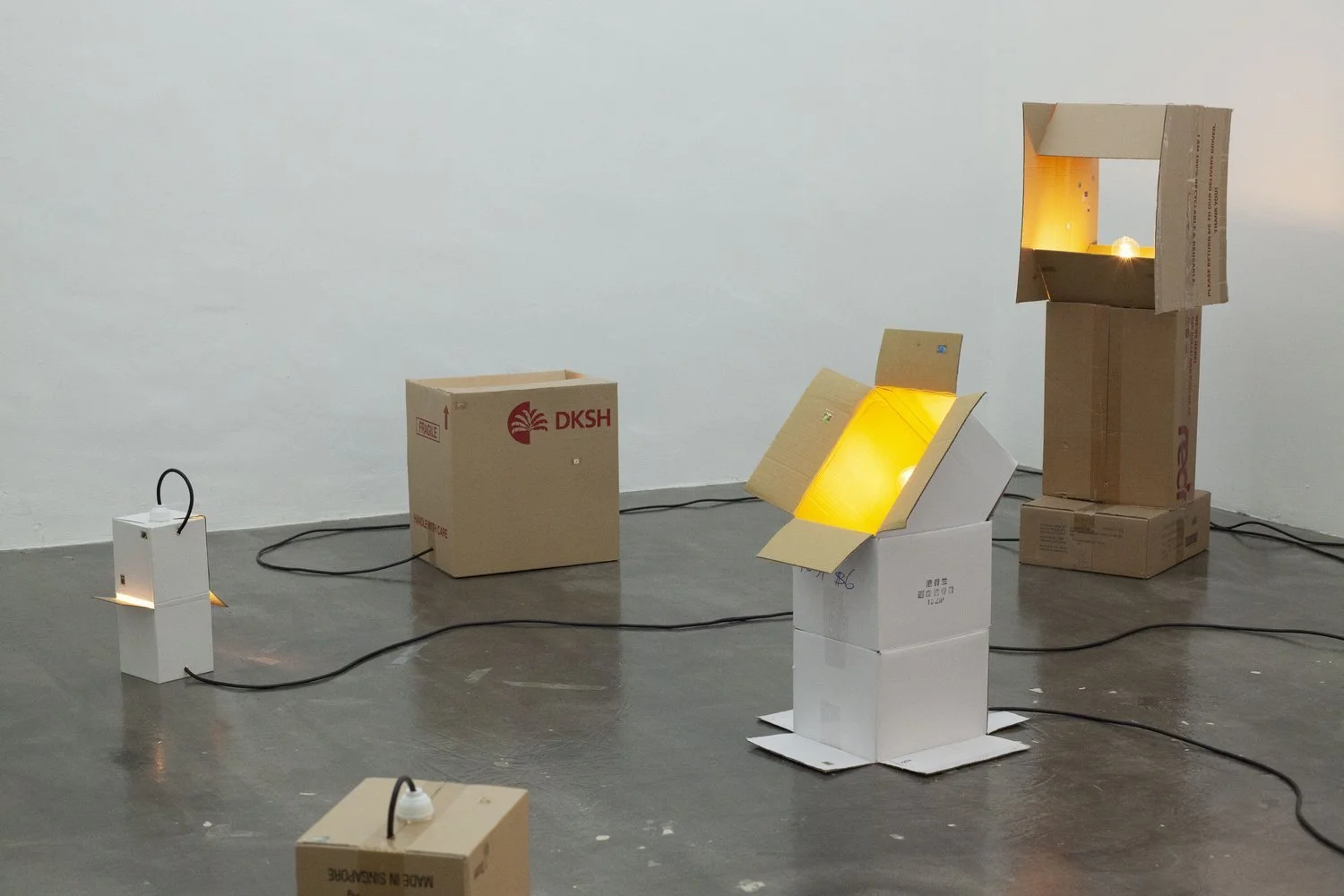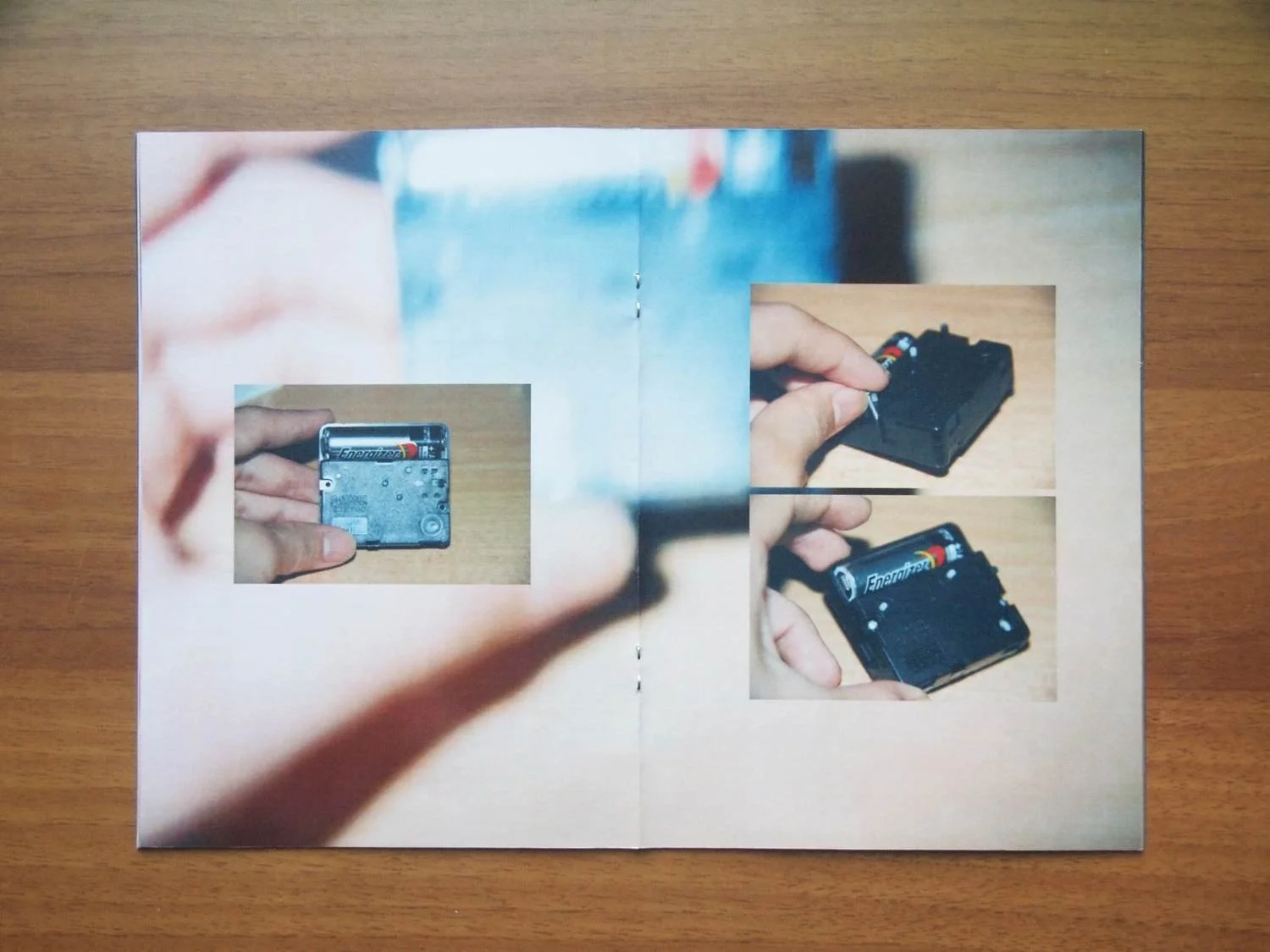Fresh Face: Lai Yu Tong
A certain modesty and a little mediocrity
A&M's Fresh Face is where we profile an emerging artist from the region every month and speak to them about how they kick-started their career, how they continue to sustain their practice and what drives them as artists.
Yu Tong in his studio.
What I find particularly compelling about Lai Yu Tong’s practice is his ability to frame and transform the mundane moments in everyday life. To quote his artist statement, he “makes works about the things he sees, things he eats, things he buys, things he throws away, and other silly things.” While some artists are identified by their unique style or an iconic body of work, I see his work as a daily practice in the truest sense. It is about his sustained engagement with idiosyncratic rituals and things, and a way of life.
His Newspaper Paintings (2018-ongoing) sets out as a project concerned with the overproduction and overconsumption of images. Yu Tong’s intervention is simple. He paints over printed texts and graphics with white acrylic paint, until a desired composition is achieved. At times, this results in unexpected relationships between the images “found” on a particular newspaper spread. With its surrounding text removed, these images are taken out of context and float, both in terms of how they appear and are understood by the viewer. Crucially, he digests the information on a page as he paints, thus creating the work without any prior planning or digital manipulation to visualise the potential outcomes.
Lai Yu Tong, Newspaper Painting No.55, 1 and 66, 2018-2019, synthetic polymer paint on newspaper, 76 x 62cm each. Image courtesy of the artist.
Even though Yu Tong started the Newspaper Paintings with stricter rules about how entire images have to be retained, as the project progressed his approach became freer. For instance, features within a photo can be isolated, opening up possibilities for compositions that break from the publication’s rigid grid layout. The artist has also observed patterns in the printing cycle, such as how specific luxury watch or jewelry advertisements would appear fortnightly in the centrefold of the Sunday papers. This feeds his interest in systems that stay invisible unless one seeks them out.
Lai Yu Tong, Cardboard Lamps & Adequate Images, 2020, cardboard, laser print on cartridge paper, clear scotch tape, LED bulb, electrical components, dimensions variable. Image courtesy of the artist.
Speaking about his tendency to use non-precious materials such as newspaper or cardboard, Yu Tong highlights modesty and mediocrity as important qualities in his work. This is most evident in Cardboard Lamps & Adequate Images (2020), an installation made out of cardboard boxes, LED bulbs and thumbnail-sized printed images taken from the artist’s phone. He describes the project as a reflection “on various personal experiences of living in Singapore, graduating from art school, getting a job, moving house and more recently, staying home during the pandemic”.
In a sense, the cardboard box can be understood for its function, as a container to store and carry one’s possessions. Yet, I also associate the material’s ephemerality with the transient nature of time. This is because a work exists in a particular moment, as an assemblage of humble objects and simple gestures. What the artist offers is a sincere touch, and that is enough.
Lai Yu Tong, Cardboard Lamps & Adequate Images, 2020, artist book, 40 pages, 3-colour risograph print, published by Temporary Press. Presented as part of an eponymous exhibition staged at Comma Space, Singapore, in November 2020. Image courtesy of the artist.
Lai Yu Tong, How To Make A Clock Spin Anti-clockwise, 2016, self-published zine, 26 pages, xerox print on office paper. Image courtesy of the artist.
Another important aspect to Yu Tong’s creative output is the making of zines and artist books. He sees it as a medium and a form of exhibition space. The publication released in conjunction with Cardboard Lamps & Adequate Images contains an instruction manual on how to build his cardboard lamps; while another zine from 2016 details the steps to make a clock spin anti-clockwise. This Do-It-Yourself ethos is at the heart of his project, an invitation to ponder and play.
Interview
Lai Yu Tong, Newspaper Paintings (Rolex), 2019, exhibition view at LASALLE College of the Arts Graduation show 2019. Image courtesy of the artist.
You studied at School of The Arts Singapore (SOTA) before pursuing a BA in Fine Arts at LASALLE College of the Arts. Did art enter your life at an early age?
Yes, I guess you could say so. I drew a lot when I was a kid and was in the art club throughout primary school. Though there was some doubt when it came to making art over doing something else, I chose it in the end.
How have you maintained your practice after graduation? What are the important factors that kept you going?
I’ve been lucky to be involved in exhibitions and art projects consistently since I graduated. This has been encouraging for me. I also maintain a constant rhythm of making and try to always have a studio space in some form, whether it is a room or a table. I think even without opportunities to show my work, I would still be making things anyway but perhaps with less confidence and a lot more self-doubt.
Lai Yu Tong, It’s strange I feel like I’ve seen this one before, 2019, first solo exhibition at DECK, Singapore. Photo by Chua Chye Teck.
How did the opportunity for your first solo presentation It’s strange I feel like I’ve seen this one before (2019) at DECK come about? Could you talk about the exhibition premise as well as one challenge you faced preparing for it?
The exhibition consists of works that involve the newspaper as a key source of media to appropriate and remix. I was thinking about the overconsumption and overproduction of images and what to do about it.
The exhibition was self-initiated at a time where I felt I had made a significant body of work to present a solo presentation. I like to DIY things, so it was a rewarding experience to go through the entire process of organising a show by myself. That said, it was challenging as it required a lot of self-belief. The process involved talking to many people to get things moving which is not easy for me as I am generally quite shy.
Lai Yu Tong, Newspaper Painting No.37 and 25, 2018-2019, synthetic polymer paint on newspaper, 76 x 62cm each. Image courtesy of the artist.
Lai Yu Tong, Cardboard Lamps & Adequate Images, 2020, cardboard, laser print on cartridge paper, clear scotch tape, LED bulb, electrical components, dimensions variable. Image courtesy of the artist.
Lai Yu Tong, Cardboard Lamps & Adequate Images, 2020, cardboard, laser print on cartridge paper, clear scotch tape, LED bulb, electrical components, dimensions variable. Image courtesy of the artist.
Your works are often made with non-precious materials such as newspaper and cardboard. Why? And how would you describe your relationship with these materials?
It is hard to explain because I did not select these materials with any preconceived intentions. Perhaps the best way to describe why I choose them is that I find them to be rather touching. Maybe because they are humble materials that are under appreciated compared to their shinier, cleaner, or more durable counterparts often used in art. I require my works to have a certain modesty to them and in some sense a little mediocrity too.
“ I require my works to have a certain modesty to them and in some sense a little mediocrity too.”
Who has been a mentor or an important artistic influence? And why?
I was fortunate to have met Robert Zhao and Heman Chong in my formative years. It was important for me to see what being a practising artist in Singapore could look like. Their advice sharpened my concepts and aesthetics as I was just starting to make art seriously. Nowadays, I like the work of Daniel Johnston and Werner Herzog.
What was one important piece of advice you were given?
Oh no… I can’t choose one. I fondly remember Alan Oei once telling everyone in a workshop about writing your artist bio: “Remember that absolutely no one gives a **** about you.” Heman Chong once told me “You don’t look like you’re having fun while making these. Remember that it is very important that you have fun.” And a hippie I met in France who was lamenting conspiracy theories and worldly problems of the 21st century ended his monologue by saying that the solution is very simple: “more love, less hate.”
Lai Yu Tong, Cardboard Lamps & Adequate Images, 2020, artist book, 40 pages, 3-colour risograph print, published by Temporary Press. Presented as part of an eponymous exhibition staged at Comma Space, Singapore, in November 2020. Image courtesy of the artist.
Lai Yu Tong, Things I Bought, Things I Threw Away, Things I Ate, Things I Saw, Things I Made, and Other Things (For Future Reference), 2019, artist book, 600 pages, digital print. Published on the occasion of browsing copy, curated by Cheng Jia Yun and Selene Yap in collaboration with Currency Design and KHL Printing. Photo by Chua Chye Teck.
You have made a number of zines and artist books. What does the medium offer to you?
I like the idea of learning and making things completely by myself even if they aren’t as polished, such as zines, cassettes, or even furniture. I made zines and circulated them before I started showing in exhibitions. With books, I like that they are more accessible to everyone in terms of their form, pricing and circulation. Since I work freely across mediums, I see the book as just another medium or another kind of exhibition space.
“With books, I like that they are more accessible to everyone in terms of their form, pricing and circulation. Since I work freely across mediums, I see the book as just another medium or another kind of exhibition space.”
Could you share your favourite art space or gallery in your country? Why are you drawn to that space and what does it offer to you or your practice?
I like soft/WALL/studs and Peninsular. They taught me a lot about what art can be; that it can be rigorous but still fun, critical but still open-minded. And I am a fan of Foxriver, a project by Mike HJ Chang.
What are your hopes for your own local art scene, and regionally as well?
I wish for more rigour and higher standards. More rigour in the way we make exhibitions and art, more rigour in our experimentation, higher standards of open-mindedness and freedom, and higher standards in the way art workers are treated. In general, I wish for more understanding all round.
Are there any upcoming exhibitions or projects that you would like to share more information on?
I’ve been busy working on some large outdoor sculptures that have been a challenge for me. They will be part of DECK’s upcoming exhibition Time Present, Time Past. And I will be presenting works alongside some good company in a show titled We’re Young Once at Art Agenda during Singapore Art Week. Lastly, Robin, a curatorial project that I started with some friends, is making exhibitions every month until March 2022, in a small camping tent popping up around Singapore.
Time Present, Time Past is on view at DECK, Singapore, from 11 to 28 January 2022.
We’re Young Once is on view at Art Agenda @ 63 Spottiswoode, from 8 to 30 January 2022.












